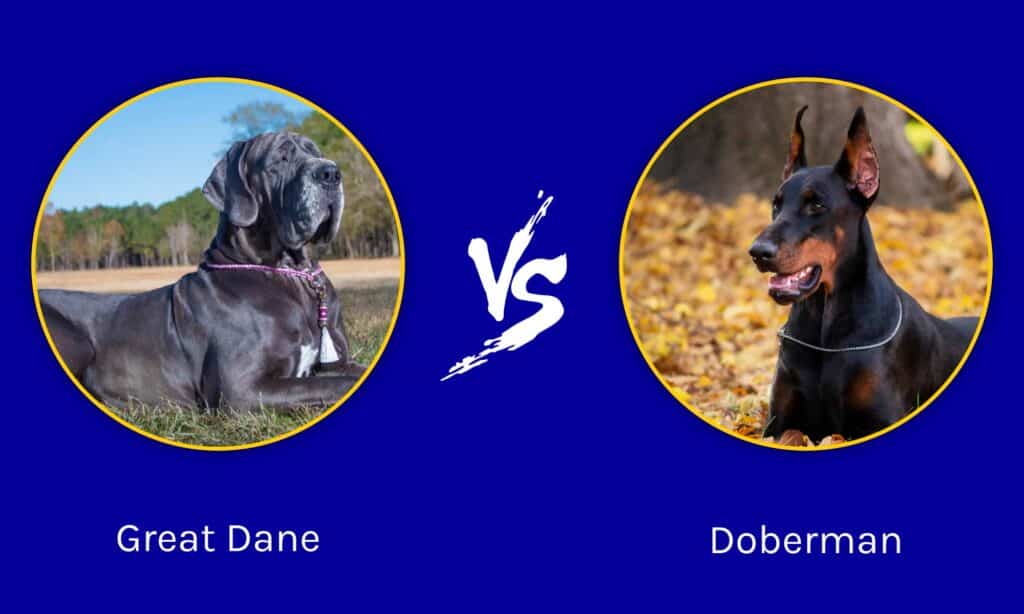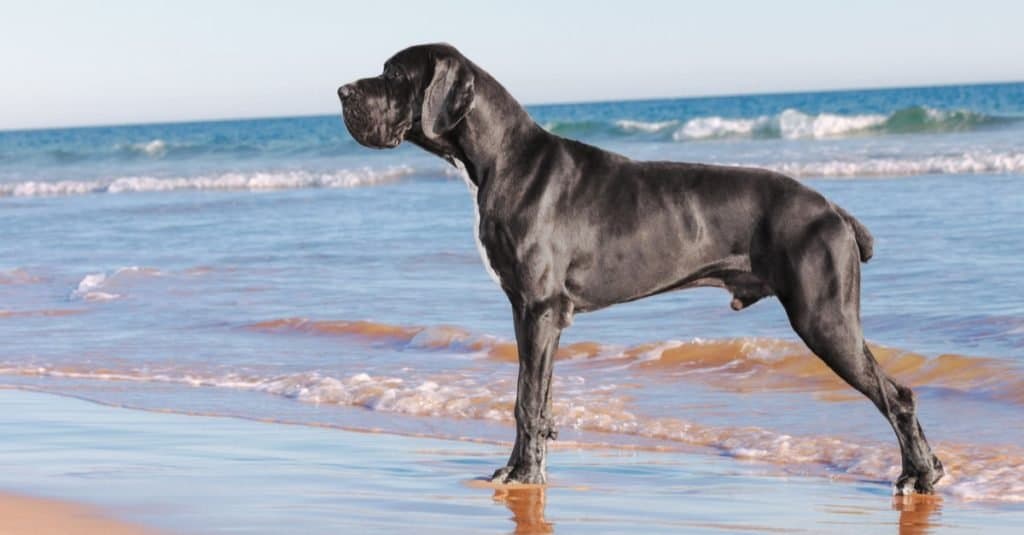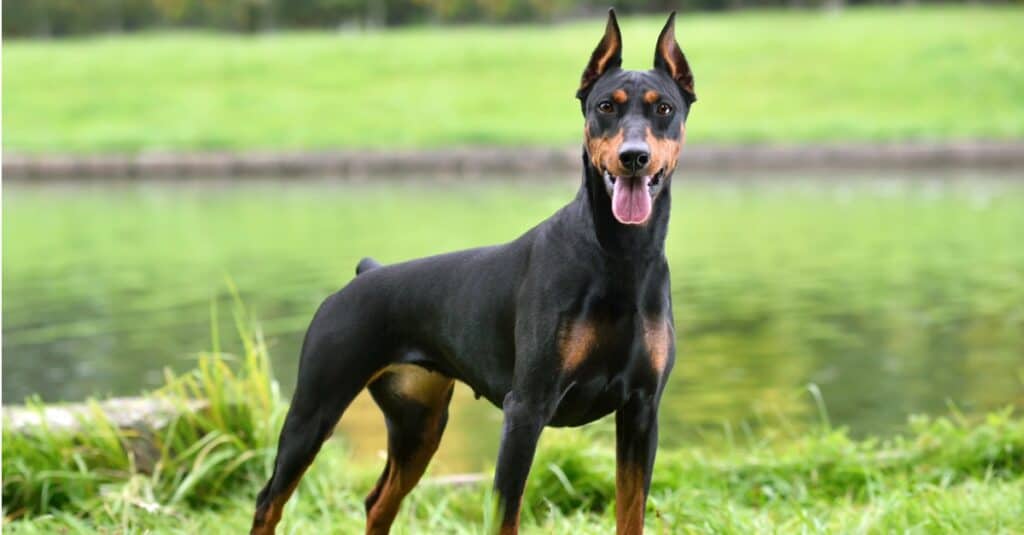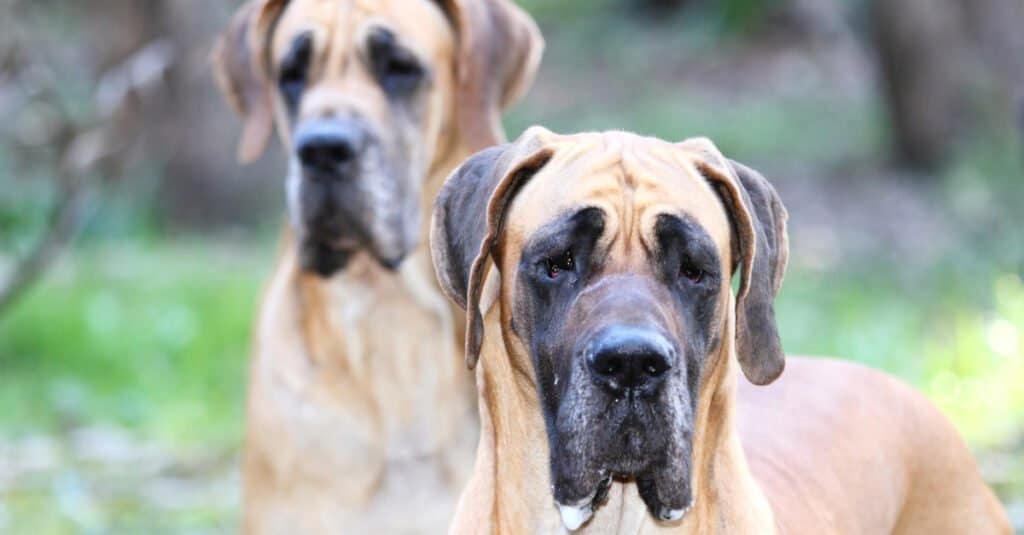If you’re considering getting a dog, you should do your homework on the breeds you’re interested in. Many dog lovers are torn between the Great Dane and the Doberman Pinscher (aka the Doberman) when it comes to huge breeds. Yet, despite their similarities, both breeds share several differences.
This article will discuss the things that differentiate these two breeds.
Great Dane vs Doberman: A Comparison

| Great Dane | Doberman | |
|---|---|---|
| Size | 28 to 34 inches 120 to 200 lbs. | 24 to 28 inches 71 to 99 lbs. |
| Coat type | Short, Fine, Dense | Short, Fine, Sleek |
| Colors | Fawn, Blue, Brindle, Merle, Black, Harlequin, Mantle | Rust and Blue, Red, Tan, Brown, White Black |
| Temperament | Gentle, Intelligent, Loving | Energetic, Obedient |
| Trainability | Above Average | Average |
| Life Expectancy | 8 to 10 Years | 10 to 13 years |
| Health Problems | Cardiomyopathy, Hip Dysplasia | Cardiomyopathy, Von Willebrand’s Disease |
Key Differences Between Great Danes and Dobermans
The key differences between Great Danes and Dobermans are appearance, characteristics, and health factors. There is a distinct difference between the Great Dane and the Doberman regarding size, not to mention that they have completely distinct builds. Doberman pinschers, for example, have long, slender heads and powerful physiques. Similarly, Great Danes look sleek and graceful, but their body and head are much larger and bulkier. These two breeds are not only distinct in appearance but also in temperament and health. Let’s dive deeper!
Appearance

Great Danes have a short, single coat that is smooth and dense.
©Jose Arcos Aguilar/Shutterstock.com
Great Dane vs Doberman: Height
Doberman males stand approximately 30-34 inches tall, while females stand approximately 28-32 inches tall. Great Danes stand between 28 and 34 inches tall.
Great Dane vs Doberman: Weight
Great Dane males weigh between 120 and 200 pounds; females weigh between 100 and 130 pounds. Doberman adult males often weigh between 88 and 99 pounds, while females typically weigh between 71 and 77 pounds.
Great Dane vs Doberman: Coat Type
Dobermans have a coat that is short, smooth, and lustrous. They shed moderately and require little maintenance. Great Danes have a short, single coat that is smooth and dense. The coat is minimal maintenance and easy to groom. In the spring, Great Danes shed more hair than they do during the year.
Great Dane vs Doberman: Color
Dobermans come in black, dark red, blue, or fawn, with rust-colored markings on the face, body, and tail. Fawn is the most common color for Great Danes. However, did you know that there are seven color variations? The American Kennel Club accepts the following coat colors: fawn, brindle, blue, black, harlequin, mantle, and merle.
Characteristics

Dobermans are very trainable, but require “respect training.”
©eAlisa/Shutterstock.com
Great Dane vs Doberman: Temperament
The temperaments of Great Danes and Dobermans are distinct. Dobermans are a high-energy breed, but Great Danes are more laid-back. In addition to their devoted nature, Great Danes are well-known for their untamed appearance. When it comes to children’s behavior, Great Danes have a better history than many other breeds.
If they’re properly socialized and taught, Dobermans are amiable and charming with people. In general, Dobermans are devoted to their owners and can have a good relationship with children if they are raised with them. Nevertheless, some have a profound attachment to only one person.
Great Dane vs Doberman: Trainability
If you’re consistent and employ positive reinforcement strategies like food rewards and praise, you’ll be able to reach your goals with the Great Dane.
Dobermans are very trainable in the appropriate hands. However, they are perceptive canines that can determine whether you are an uninspiring individual. They require a self-assured owner. “Respect Training” is necessary to teach your Doberman to listen to you.
Health Factors

Great Danes have a lifespan of 8-10 years, shorter than most dog breeds.
©Jesus Souto/Shutterstock.com
Great Dane vs Doberman: Health Problems
The following conditions are common in Great Danes:
- Allergies
- Bloating
- Cardiomyopathy
- Cataracts
- Hip Dysplasia
- Non-Tumorous Skin Growths
- Osteosarcoma
- Skin Irritation
- Wobbler Syndrome
Hip dysplasia is also a prevalent problem in large breeds like Great Danes and Dobermans. Dobermans are also prone to:
- Albinism
- Hypothyroidism
- Narcolepsy
- Von Willebrand’s Illness
- Wobbler’s Syndrome
Great Dane vs Doberman: Life Expectancy
Because of their size and inherent health risks, Great Danes have a shorter lifespan than most other breeds. They live an average of 8 to 10 years. Dobermans have an average lifespan of 10 to 13 years, which is the average for most dog breeds.
Wrapping up Great Dane vs Doberman
The Doberman Pinscher is an excellent choice for a family dog that is protective, loyal, and easy to train. The Great Dane is an excellent choice for a calm, friendly, sociable, and protective family dog. In either case, Dobermans and Great Danes make great companion dogs. Their intelligence, sociability, and dedication to their people make them ideal family pets.
The photo featured at the top of this post is © belu gheorghe/Shutterstock.com
Ready to discover the top 10 cutest dog breeds in the entire world?
How about the fastest dogs, the largest dogs and those that are -- quite frankly -- just the kindest dogs on the planet? Each day, AZ Animals sends out lists just like this to our thousands of email subscribers. And the best part? It's FREE. Join today by entering your email below.
Thank you for reading! Have some feedback for us? Contact the AZ Animals editorial team.






